HP StoreOnce Backup User Manual

HP StoreOnce
6500 and B6200 Backup system user guide
Abstract
This is the user guide for HP StoreOnce 6500 and B6200 Backup system and is intended for users who install, operate and maintain the HP StoreOnce Backup system.
Always check www.hp.com/go/storage/docs for the most current documentation, including localized versions (in PDF format) for your product. (Search on Product Name and select the Product Manuals option.)
Refer to the Quick Specs on http://www.hp.com/go/storeonce for supported features for your model and the current status.
HP Part Number: BB897-90924
Published: July 2014
Edition: 11

© Copyright 2011–2014 Hewlett-Packard Development Company, L.P.
Confidential computer software. Valid license from HP required for possession, use or copying. Consistent with FAR 12.211 and 12.212, Commercial Computer Software, Computer Software Documentation, and Technical Data for Commercial Items are licensed to the U.S. Government under vendor's standard commercial license.
The information contained herein is subject to change without notice. The only warranties for HP products and services are set forth in the express warranty statements accompanying such products and services. Nothing herein should be construed as constituting an additional warranty. HP shall not be liable for technical or editorial errors or omissions contained herein.
Warranty
WARRANTY STATEMENT: To obtain a copy of the warranty for this product, see the warranty information website: http://www.hp.com/go/storagewarranty
Acknowledgments
Linear Tape-Open, LTO, LTO Logo, Ultrium and Ultrium Logo are trademarks of Quantum Corp, HP and IBM in the US, other countries or both.
Microsoft, Windows, Windows NT, and Windows XP are U.S. registered trademarks of Microsoft Corporation. Intel and Itanium are trademarks or registered trademarks of Intel Corporation or its subsidiaries in the United States and other countries.
The HP StoreOnce Backup system product firmware includes software developed by the OpenSSL Project for use in the OpenSSL Toolkit. (http:// www.openssl.org/).
Revision History |
|
Revision 1 |
November 2011 |
First edition, issued with the launch of the HP StoreOnce B6200 Backup system.
Revision 2 June 2012
Second edition, includes the major StoreOnce feature updates, StoreOnce Catalyst.
Revision 3 November 2012
Third edition, issued with the launch of the HP StoreOnce 2620, 4210/4220 and 4420/4430 Backup system. It should also be used with HP StoreOnce B6200 Backup systems running 3.5.0 software.
Revision 4 |
May 2013 |
Fourth edition, issued with the 3.6.0 version of HP StoreOnce software and valid for all HP StoreOnce Backup systems. |
|
Revision 5 |
June 2013 |
Fifth edition, issued with the 3.7.0 version of HP StoreOnce software and valid for the HP StoreOnce VSA Backup system only.
Revision 6 July 2013
Sixth edition, issued with the 3.8.0 version of HP StoreOnce software and valid for HP StoreOnce 2700, 4500, 4700, and 4900 Backup systems only. It is not valid for the HP StoreOnce B6200 Backup system or the HP StoreOnce VSA Backup system.
Revision 7 September 2013
Seventh edition, issued with the 3.9.0 version of HP StoreOnce software.
Revision 8 January 2014
Eighth edition, issued with the 3.10.0 version of HP StoreOnce software.
Revision 9 |
January 2014 |
Ninth edition, contains minor text updates. |
|
Revision 10 |
February 2014 |
Tenth edition, contains minor text updates. |
|
Revision 11 |
July 2014 |
Eleventh edition, issued with the 3.11.0 version of the HP StoreOnce software.

Contents |
|
1 Getting started........................................................................................... |
8 |
This guide................................................................................................................................ |
8 |
Overview of HP StoreOnce Backup products................................................................................ |
8 |
User types and user roles........................................................................................................... |
9 |
Network configuration............................................................................................................. |
10 |
Power off and power on.......................................................................................................... |
10 |
Navigating the HP StoreOnce Graphical User Interface (GUI)...................................................... |
10 |
Navigating the online help...................................................................................................... |
11 |
The StoreOnce CLI.................................................................................................................. |
13 |
Licensing............................................................................................................................... |
13 |
Security Features.................................................................................................................... |
14 |
2 StoreOnce functions.................................................................................. |
17 |
Overview of the HP StoreOnce page......................................................................................... |
17 |
Select service set dialog.......................................................................................................... |
18 |
Maximum device considerations.......................................................................................... |
19 |
System information and status................................................................................................... |
19 |
3 VTL (Virtual Tape Libraries) functions........................................................... |
21 |
VTL Configuration page........................................................................................................... |
21 |
Fibre Channel Settings tab.................................................................................................. |
21 |
Port assignment for StoreOnce Backup systems.................................................................. |
22 |
Libraries page........................................................................................................................ |
23 |
Device Details tab.............................................................................................................. |
24 |
To create a new library (administrators only)..................................................................... |
26 |
To edit library details (administrators only)........................................................................ |
27 |
To delete a library (administrators only)............................................................................ |
28 |
Emulation types for tape devices.......................................................................................... |
28 |
Interface Information tab..................................................................................................... |
29 |
To change drive assignment on Fibre Channel ports........................................................... |
30 |
Cartridges tab................................................................................................................... |
30 |
To create a cartridge (administrators only)........................................................................ |
32 |
To delete a cartridge (administrators only)........................................................................ |
32 |
To delete all or a range of cartridges (administrators only).................................................. |
33 |
To write protect a cartridge (administrators only)............................................................... |
33 |
To edit maximum cartridge size (administrators only).......................................................... |
34 |
To move or unload cartridges......................................................................................... |
34 |
To edit barcodes in bulk................................................................................................. |
35 |
Make Replication Target libraries visible to the host..................................................................... |
36 |
4 NAS functions.......................................................................................... |
38 |
NAS Configuration page......................................................................................................... |
38 |
Service sets and NAS servers.............................................................................................. |
38 |
CIFS Server tab...................................................................................................................... |
38 |
Configuring user authentication............................................................................................ |
40 |
Configuring CIFS Server with AD and CIFS Share with AD domain users........................................ |
42 |
NFS Server tab....................................................................................................................... |
50 |
Shares (NAS)......................................................................................................................... |
51 |
Creating a CIFS share........................................................................................................ |
53 |
Creating an NFS share and setting permissions..................................................................... |
55 |
5 Replication functions................................................................................. |
59 |
What is an appliance?............................................................................................................ |
59 |
Contents 3
How do I identify the IP address of a Service Set?.................................................................. |
60 |
Status tab.............................................................................................................................. |
61 |
Partner Appliances (Replication)............................................................................................... |
62 |
Target Appliances tab........................................................................................................ |
63 |
Source Appliances tab....................................................................................................... |
65 |
Source Appliance Permissions tab........................................................................................ |
65 |
Local Settings (Replication) tab................................................................................................. |
67 |
General settings tab........................................................................................................... |
67 |
Bandwidth Limiting tab....................................................................................................... |
69 |
Blackout Windows tab........................................................................................................ |
70 |
Event History (Replication) tab.................................................................................................. |
70 |
VT Mappings (Replication)....................................................................................................... |
71 |
Source and target library mappings..................................................................................... |
72 |
Running the replication wizard (virtual tape devices)............................................................... |
74 |
Recovering a Source Appliance (Virtual Tape devices)............................................................ |
77 |
NAS Mappings (Replication).................................................................................................... |
80 |
Source and target share details............................................................................................ |
81 |
Running the replication wizard (NAS)................................................................................... |
82 |
Recovering a Source Appliance (NAS shares)........................................................................ |
86 |
Reverse replication using the wizard................................................................................ |
86 |
Promoting a Target Share over the WAN using NAS......................................................... |
89 |
6 HP StoreOnce Catalyst functions................................................................. |
90 |
What is HP StoreOnce Catalyst?.............................................................................................. |
90 |
StoreOnce Catalyst terminology................................................................................................ |
91 |
StoreOnce Catalyst page......................................................................................................... |
91 |
StoreOnce Catalyst Status tab.............................................................................................. |
93 |
StoreOnce Catalyst Settings tab........................................................................................... |
94 |
StoreOnce Catalyst Clients tab............................................................................................ |
95 |
StoreOnce Catalyst Blackout Windows tab............................................................................ |
96 |
StoreOnce Catalyst Bandwidth Limiting Windows tab............................................................. |
97 |
Fibre Channel Settings tab.................................................................................................. |
98 |
Catalyst Stores page............................................................................................................... |
99 |
Store details tab.............................................................................................................. |
100 |
Permissions tab (administrators only)................................................................................... |
103 |
Item summary tab............................................................................................................ |
103 |
Data jobs tab.................................................................................................................. |
105 |
Outbound copy jobs tab................................................................................................... |
108 |
Inbound copy jobs tab...................................................................................................... |
112 |
System information messages............................................................................................. |
116 |
Federated Stores page.......................................................................................................... |
117 |
7 Housekeeping function............................................................................ |
119 |
The Housekeeping page........................................................................................................ |
119 |
Configuring blackout windows................................................................................................ |
122 |
Pausing housekeeping........................................................................................................... |
122 |
8 StoreOnce reporting............................................................................... |
124 |
Activity report....................................................................................................................... |
124 |
Reporting page.................................................................................................................... |
125 |
9 Storage Reporting.................................................................................. |
127 |
Storage Report..................................................................................................................... |
127 |
10 Hardware............................................................................................ |
128 |
Monitoring the StoreOnce Backup server ................................................................................ |
129 |
Differences between systems.............................................................................................. |
131 |
4Contents
Monitoring switches.............................................................................................................. |
132 |
|
Monitoring the storage ......................................................................................................... |
133 |
|
Drives (enclosure).................................................................................................................. |
134 |
|
11 Remote Support.................................................................................... |
136 |
|
Remote Support page........................................................................................................... |
136 |
|
Configuring and modifying remote support.............................................................................. |
137 |
|
Customer Information page.................................................................................................... |
138 |
|
Entering and modifying customer information...................................................................... |
138 |
|
Server page......................................................................................................................... |
139 |
|
Entering and modifying entitlement information for the servers............................................... |
139 |
|
Storage page....................................................................................................................... |
140 |
|
Entering and modifying entitlement information for storage expansions................................... |
140 |
|
Switch page......................................................................................................................... |
141 |
|
Entering and modifying entitlement information for switches................................................... |
142 |
|
Status page......................................................................................................................... |
143 |
|
12 Access and Device Configuration............................................................ |
144 |
|
Device Configuration page.................................................................................................... |
144 |
|
User Management................................................................................................................ |
144 |
|
To add a user (Admin only)............................................................................................... |
145 |
|
To add a group (Admin only)............................................................................................ |
146 |
|
To modify a user.............................................................................................................. |
147 |
|
To delete a user or group (Admin only)............................................................................... |
148 |
|
Email.................................................................................................................................. |
|
148 |
Test |
email....................................................................................................................... |
149 |
Events (Email).................................................................................................................. |
149 |
|
To manage email notifications........................................................................................... |
150 |
|
Support |
Ticket...................................................................................................................... |
150 |
Data |
collection................................................................................................................ |
151 |
Collect Data............................................................................................................... |
152 |
|
Download data collection............................................................................................ |
153 |
|
Delete data collection.................................................................................................. |
153 |
|
13 Events.................................................................................................. |
154 |
|
To delete events from the log.................................................................................................. |
154 |
|
14 Configuration save and restore process.................................................... |
156 |
|
Configuration file.................................................................................................................. |
156 |
|
When should a configuration file be generated?.................................................................. |
156 |
|
Contents of the configuration text file ...................................................................................... |
156 |
|
Settings restored after automatic recovery ............................................................................... |
158 |
|
Performing a configuration save ............................................................................................. |
159 |
|
Prerequisites for a configuration restore ................................................................................... |
159 |
|
Restoring from the configuration zip file................................................................................... |
159 |
|
Performing a full configuration restore on a StoreOnce Backup system.......................................... |
160 |
|
Deleting configuration files from an appliance.......................................................................... |
160 |
|
15 Storage management............................................................................ |
161 |
|
RAID configuration............................................................................................................... |
161 |
|
Identifying a leftover disk....................................................................................................... |
161 |
|
Identifying a failed disk......................................................................................................... |
162 |
|
Replacing a hot plug disk in a 6500 disk enclosure.................................................................. |
163 |
|
Important Safety information.............................................................................................. |
163 |
|
To install the drives........................................................................................................... |
163 |
|
Replacing a hot-plug hard disk in a 12–disk array (HP B6200)................................................... |
166 |
|
If several disks fail................................................................................................................ |
167 |
|
Contents 5
Expanding storage after adding storage.................................................................................. |
168 |
16 Failover .............................................................................................. |
169 |
What is failover?.................................................................................................................. |
169 |
Controlled failover........................................................................................................... |
169 |
Uncontrolled failover........................................................................................................ |
169 |
What happens during failover?.............................................................................................. |
169 |
What does the user need to do?............................................................................................. |
171 |
Running failback................................................................................................................... |
171 |
17 Basic troubleshooting............................................................................ |
172 |
Accessing the CLI................................................................................................................. |
172 |
Password problems............................................................................................................... |
173 |
Pulling a Support Ticket......................................................................................................... |
173 |
Licensing problems............................................................................................................... |
173 |
Multiple users....................................................................................................................... |
174 |
Connecting to the StoreOnce Backup system from the backup application.................................... |
174 |
Timeout problems with NAS CIFS shares.................................................................................. |
174 |
Power off and power on........................................................................................................ |
175 |
NFS State handle error.......................................................................................................... |
175 |
If backup or replication fails................................................................................................... |
175 |
Catalyst troubleshooting........................................................................................................ |
176 |
Performance......................................................................................................................... |
176 |
StoreOnce Backup system configuration problems..................................................................... |
176 |
Upgrade licenses.................................................................................................................. |
177 |
18 Advanced troubleshooting...................................................................... |
178 |
Important information about serial numbers.............................................................................. |
178 |
Recording bundled serial numbers..................................................................................... |
179 |
Power off and power on........................................................................................................ |
179 |
Enabling power on after power has been lost...................................................................... |
179 |
Powering on disk enclosures, HP StoreOnce 6500 Backup................................................ |
180 |
Powering on expansion shelves, HP StoreOnce B6200 Backup.......................................... |
180 |
Powering on the node (server)....................................................................................... |
181 |
Powering off using the StoreOnce CLI................................................................................. |
184 |
Powering on ................................................................................................................... |
184 |
If power on is unsuccessful........................................................................................... |
184 |
Rebooting the system........................................................................................................ |
185 |
Networking problems............................................................................................................ |
185 |
Internal network switches................................................................................................... |
185 |
Reserved IP address......................................................................................................... |
186 |
Problems connecting from the network................................................................................ |
186 |
Network troubleshooting and failover................................................................................. |
187 |
IP addresses and couplet/rack expansion........................................................................... |
187 |
VLAN networking problems................................................................................................... |
187 |
Software update process....................................................................................................... |
187 |
Firmware updates................................................................................................................. |
188 |
What happens to the GUI during failover................................................................................ |
188 |
Running failback.............................................................................................................. |
189 |
Failover with CIFS Server in AD authentication..................................................................... |
189 |
If the HP StoreOnce Backup system runs out of disk space.......................................................... |
192 |
Reduced performance using Data in Flight Encryption................................................................ |
193 |
Replacement of hardware...................................................................................................... |
193 |
Quick Restore ISO Image ...................................................................................................... |
193 |
19 SNMP................................................................................................. |
194 |
SNMP (Configuration)........................................................................................................... |
194 |
6Contents
HP Systems Insight Manager............................................................................................. |
194 |
20 Key Parameters.................................................................................... |
199 |
StoreOnce 6500 and B6200 Backup...................................................................................... |
199 |
21 Support and other resources................................................................... |
202 |
Contacting HP...................................................................................................................... |
202 |
Subscription service.......................................................................................................... |
202 |
Related information............................................................................................................... |
202 |
Websites........................................................................................................................ |
203 |
Typographic conventions....................................................................................................... |
203 |
Customer self repair.............................................................................................................. |
204 |
A Upgrading to StoreOnce software, version 3.11.x........................................ |
205 |
Previous networking models................................................................................................... |
205 |
Network model with StoreOnce software version 3.11.0 and later................................................ |
206 |
Bonding modes............................................................................................................... |
206 |
VLAN subnets with HP StoreOnce Backup................................................................................ |
207 |
VLAN guidelines.............................................................................................................. |
207 |
Example network environment........................................................................................... |
208 |
Updating to StoreOnce 3.11.0 software.................................................................................... |
208 |
Worked example ................................................................................................................. |
209 |
View current configuration................................................................................................. |
209 |
Modifying the current configuration.................................................................................... |
210 |
Best practise............................................................................................................... |
210 |
To add a third subnet ...................................................................................................... |
211 |
To add VLAN subnets....................................................................................................... |
211 |
To modify the existing 10GbE portset and add a VLAN subnet.......................................... |
211 |
To create a new portset that is VLAN enabled and add a VLAN subnet.............................. |
212 |
To add IP addresses to a subnet......................................................................................... |
212 |
To add Data in Flight Encryption........................................................................................ |
213 |
License requirements.................................................................................................... |
213 |
Configuring the client................................................................................................... |
213 |
Configuring the StoreOnce Backup system...................................................................... |
213 |
Configuring IPsec on the media server........................................................................... |
214 |
Encryption with replication........................................................................................... |
214 |
B Regulatory information............................................................................ |
215 |
Belarus Kazakhstan Russia marking......................................................................................... |
215 |
Turkey RoHS material content declaration................................................................................. |
215 |
Ukraine RoHS material content declaration.............................................................................. |
215 |
Warranty information............................................................................................................ |
215 |
Index....................................................................................................... |
217 |
Contents 7

1 Getting started
The following topics are covered in this chapter:
•This guide (page 8)
•Overview of HP StoreOnce Backup products (page 8)
•User types and user roles (page 9)
•Network configuration (page 10)
•Power off and power on (page 10)
•Navigating the StoreOnce Graphical User Interface (GUI) (page 10)
•Navigating the online help (page 11)
•The StoreOnce CLI (page 13)
•Licensing (page 13)
•Security Features (page 14)
This guide
This guide contains detailed information on using the StoreOnce GUI and includes some Command Line Interface commands and troubleshooting information.
•Tasks available only in the StoreOnce GUI are described only in this guide.
•Tasks available in both the GUI and CLI are described in this guide. (The CLI command is described in greater detail in the HP StoreOnce Backup system CLI Reference Guide.)
•Tasks only available in the CLI are described fully in the HP StoreOnce Backup system CLI Reference Guide. Those tasks may not be described in this guide.
Overview of HP StoreOnce Backup products
The HP StoreOnce 6000 series of modular systems features HP inline deduplication and network efficient technology and offers extended capacity for Enterprise-class storage.
Table 1 StoreOnce B6200 and 6500 models
Product model |
Description |
Ports |
HP StoreOnce B6200 |
Rack system with up to four |
8 x 1GbE ports 4 x 10GbE |
Backup |
couplets. Each couplet |
ports8 x FC ports |
|
contains two nodes (servers) |
|
|
and two 12–disk RAID |
|
|
storage controllers |
|
 Storage expansion
Storage expansion
Up to six 12–disk storage shelves per couplet (three per node)
HP StoreOnce 6500 Backup Rack system with up to four couplets. Each couplet contains two nodes (servers) and two pre-configured two-drawer disk enclosures, each with eleven 4TB disks and four hot spare disks
8 x 1GbE ports 4 x 10GbE ports8 x FC ports
Up to five 22–disk expansion kits for the two disk enclosuresOnce all bays in both disk enclosures are full, further expansion is by adding a couplet
The HP StoreOnce B6200 and 6500 Backup systems are composed of 1 to 4 couplets (the size depends on the customer-specific configuration). A couplet is a paired combination of two nodes that are directly connected in failover pairs. Within a couplet each node can access and assume
8Getting started

the role of both nodes in the event of node failure. Storage capacity within a single couplet can be expanded in increments by adding:
•HP StoreOnce B6200 Backup: pairs of 12–disk storage shelves up to a maximum of three pairs per couplet.
•HP StoreOnce 6500 Backup: up to five 22–disk expansion kits for the two disk enclosures in each couplet.
Couplets are combined into logical groups managed from a single StoreOnce Graphical User Interface (GUI) and Command Line Interface (CLI). This collection of couplets is called a cluster.
Using StoreOnce software version 3.11.00, you can add StoreOnce 6500 couplets to a StoreOnce B6200 Backup system. This configuration is referred to as a mixed cluster configuration.
User types and user roles
User roles
Two roles define the permissions associated with a user; admin and user. Two default user accounts, one for each role, are created automatically when the system is installed:
•Administrator: Authorized users can create and edit management and StoreOnce functions via the GUI and CLI. The default login and password are Admin and admin. The permissions role of the Administrator is admin. You cannot delete this account, but you can and should modify its password. Note that once the Admin account password has been changed, its password cannot be changed back to admin as this password is not sufficiently complex. The only way to revert that password back to admin is via the HPresetpassword account which is only available on the local console of the device.
•Operator: This account limits access to the GUI and CLI to monitoring and viewing. The default login and password are Operator and operator. The permissions role of the Operator is user.
User types
After installation, an Administrator can configure additional user accounts and assign permissions roles (admin or user) and passwords to these users. See the HP StoreOnce Backup system user guide.
There are three types of user accounts:
•Local User (with an administrator or user permissions role): Local users log in locally.
•External User (with an administrator or user permissions role): User logs in as a domain user. An external user is a Microsoft Active Directory user.
•External Group (with an administrator or user permissions role): An external user is a Microsoft Active Directory group. Members of the group log in as domain users. If after creating a group you then set up a member of that group as an individual user (external user) and give them an administrator role, that user will be an administrator, even if the group role is set to user. This is because role permissions set through Add User take precedence over role permissions set through Add Group.
Any user with an admin role has the same permissions as the default Administrator. Any user with a user role will have the same permissions as the default Operator.
NOTE: To add external users or groups, first add the StoreOnce device to an AD domain. Connection to an AD Domain is configured through the NAS CIFS server tab on the StoreOnce GUI. See Configuring CIFS Server with AD and CIFS Share with AD domain users (page 42).
User types and user roles |
9 |
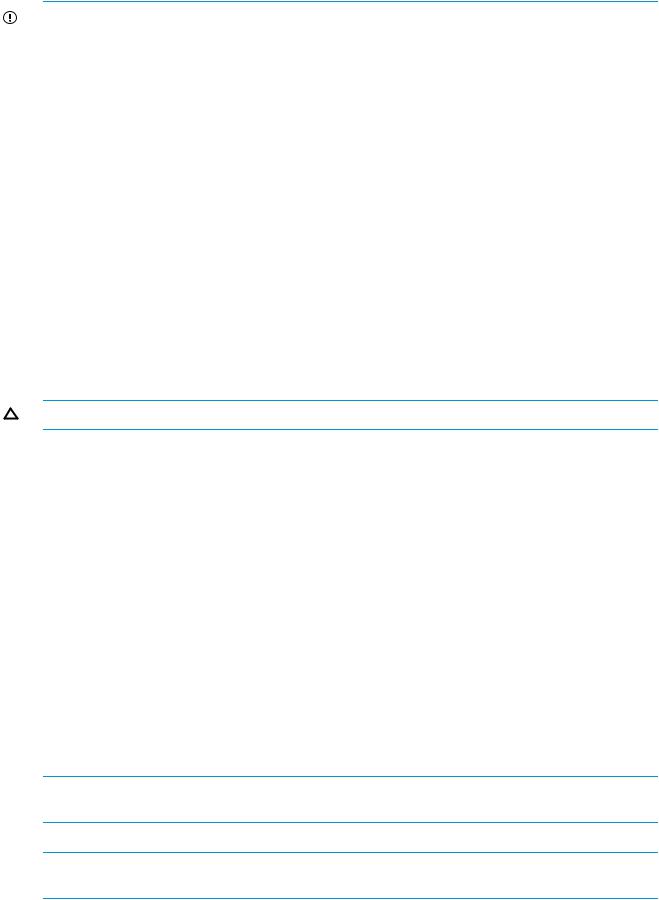
IMPORTANT: If Admin credentials are lost, the Admin password can be reset through the account “HPresetpassword”. This account is password protected and is only accessible from the StoreOnce console and CLI. HP recommends the end-user change the HPresetpassword password after installation and store it in an offline Password Security tool.
Tip
To identify current user rights view the title bar of the GUI. This shows your user Type, Name, and Role. See (page 11).
Network configuration
The StoreOnce Backup system must be configured on the network.
Network configuration should only be changed under the guidance of HP Support.
Power off and power on
No commands within the GUI control the power on/off or reboot of a StoreOnce Backup system (node or cluster). Power on/off commands must be run from the StoreOnce CLI. See the HP StoreOnce Backup CLI Reference Guide and your product’s HP StoreOnce Backup system user guide for more information.
The system is installed and powered on initially by HP service engineers. However, it may be necessary to power off or reboot individual elements, such as server nodes, after installation.
CAUTION: Failover the node before a reboot in case of unexpected errors with the node.
Navigating the HP StoreOnce Graphical User Interface (GUI)
The HP StoreOnce GUI and CLI together make up the Management Console. While there is overlap in what operations you can perform, not all operations are available from both interfaces.
The HP StoreOnce GUI is the main interface for:
•Monitoring the status and health of the HP StoreOnce Backup system and all configured backup devices
•Creating and modifying VTL and NAS StoreOnce backup targets and Catalyst stores
•Managing replication relationships and housekeeping
To run the StoreOnce GUI
Log on to the StoreOnce GUI using a browser on any machine connected to the management network; see “User types and user roles” (page 9) for default login information. The HP StoreOnce Backup system uses a secure network connection.
Enter: https://<VIF_address>. (The VIF_address is the IP address that was assigned for logging on to the StoreOnce GUI when the system was installed. It is also called the Cluster Management IP address.)
NOTE: Entering http: in the URL path will automatically forward to the https: secure network connection.
The StoreOnce GUI displays the Login prompt.
NOTE: The web browser requires Active Scripting or JavaScript enabled. If both are disabled, some browser buttons may not be displayed.
10 Getting started
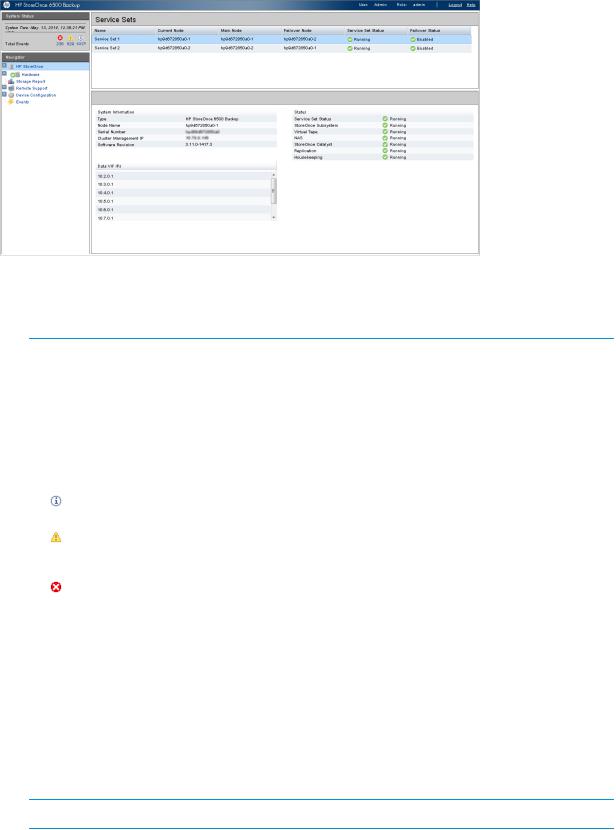
GUI components
The GUI includes:
•Title bar: Displays the HP StoreOnce Backup system model, the user name and role, and contains the Logout and Help buttons.
NOTE: After 15 minutes of inactivity, the session times out and returns to the Login screen.
•System Status (top left side panel): Displays the last time the system was updated (the machine time) and a count of event status categories.
The three icons described below are used in the System Status area. They do not identify the event that has affected the status. To view the individual events for more detail, select Events from the Navigator, as described in Events (page 154).
Indicates standard information.
Indicates a warning state. Attention is needed but the error is not critical to the successful operation of the device. For example, a single disk failure occurs or disks are installed in an expansion shelf but not licensed.
Indicates a critical state. The system requires immediate attention. This icon may also appear in the Details area of the screen with a red square background (rather than a red circle).
•Navigator (left side panel): Displays available GUI topics and enables navigation to selected topic pages. A + sign next to a topic indicates additional options; click + to expand the selection and click — to contract the selection.
•Topic page (main window): Initially, the main window displays the top-level StoreOnce topic page. Select another topic from the Navigator to display the page for that selection. Some Topic pages require selection of an item, such as a service set, library, NAS share, or Catalyst store in the top half of the page to display details specific to the selected item in the lower half of page. Some Topic pages include multiple tabs within the page, for example the VTL—Libraries page. Select a tab to display information and actions appropriate to that tab.
NOTE: For more information about service sets, see Select service set dialog (page 18).
Navigating the online help
The Help link in the top right-hand corner of each page displays context-sensitive information for the current page.
Navigating the online help |
11 |
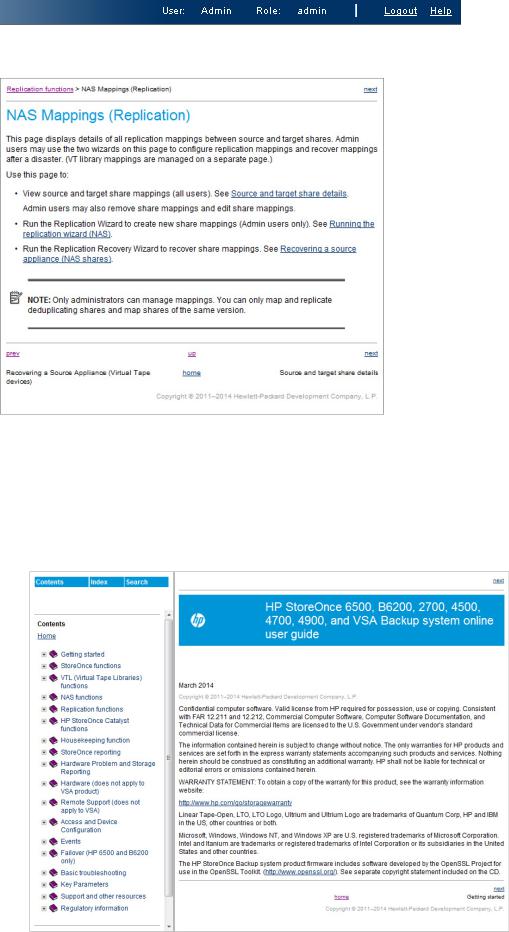
The following example displays the Help when selected from the NAS Mappings page.
•Click and drag on a side or a corner to expand or contract the Help window.
•The header displays the page where the help was called. Links navigate to the next or previous pages; the titles of the next and previous pages are beneath the respective links.
•The footer also provides navigation options. Select home to access the help Home page which provides access to the complete online help and Contents, Search, and Index options. Resize the page to view all of the content.
12 Getting started

The StoreOnce CLI
The StoreOnce Command Line Interface (CLI) provides an alternative way of administering and monitoring the system. Some tasks are only accessible from the StoreOnce CLI.
StoreOnce CLI commands require an SSH client application (freely available from the internet) and must be run from a SSH terminal session as described in Accessing the CLI (page 172).
See the HP StoreOnce Backup system CLI Reference Guide for more information about the StoreOnce CLI commands.
Licensing
Licensing requirements
The HP StoreOnce Backup system licensing requirements are:
•All capacity expansion must be licensed. Each storage expansion kit contains a license that must be loaded.
•No licensing is required for VTL or NAS emulations.
•VTL and NAS replication requires a license (per couplet) on the target system but only if VTL/ NAS replication is used on that couplet.
•OST/Catalyst devices require a license for backup and for copy so licenses must be installed on both origin and destination systems, but those systems do not require a replication license.Catalyst is licensed per couplet. If a couplet is not using Catalyst stores no license is required.
•Security features (Data at Rest Encryption, Data in Flight Encryption, and Secure Erase) require a security license. A Security license, if required, must be installed on every couplet on the cluster. If you do not add a Security license for each couplet, the security feature becomes unlicensed for the whole HP StoreOnce Backup system.
NOTE: Licenses can only be applied from the StoreOnce CLI. See the HP StoreOnce CLI Reference Guide for more information.
Types of licensing
There are two types of licensing:
•Full license (not time-limited).
•Instant On (time-limited to 90 days): Trial period for licensed functionality on StoreOnce hardware products for features such as Replication Target and Catalyst This license cannot be used with capacity expansion or the security features of Data at Rest Encryption and Secure Erase. For more information on applying this type of license, see the HP StoreOnce Backup system CLI Reference Guide.
To apply a license
Features that require a license include a license entitlement certificate with the product. This is either an electronic document provided at purchase, such as Replication, Catalyst, Security (Data at Rest Encryption or Secure Erase), or a paper document provided with a capacity upgrade kit. The document contains all information required to obtain a unique License to Use (LTU) key. Obtain the key from the HP Webware site by connecting to the web address specified on the certificate and following the instructions. (Users without Internet access may use the contact numbers provided with the entitlement certificate.)
You will be required to enter the product's serial number when requesting an LTU key.
The StoreOnce CLI 13

1.Obtain the unique LTU key as instructed on the License Entitlement Certificate. This is normally from the HP Licensing website at http://www.webware.hp.com. HP recommends saving the license to a .DAT file. The file can also be emailed to the registered license owner's email address, or Cut and Paste to copy it to a temporary file.
IMPORTANT: When redeeming licenses for replication and additional storage, Webware will ask you to provide a serial number. The number you should use is the System ID that can be found on the Device Configuration page.
2.If you save the LTU as a file, sftp it into the HP StoreOnce Backup system's repository directory.
•Using Linux
sftp Admin@<Management_VIF> cd repository)
put <LTU>.dat exit sftp
•Using a Windows sftp client
Ensure the File Protocol is set to SFTP, not SCP. Login to the StoreOnce GUI as Admin. Copy <LTU>.dat to repository.
3.Verify the LTU is stored within the repository using StoreOnce CLI command: system show repository.
Look for the <LTU>.dat file.
4.Apply the license using one of the following StoreOnce CLI commands:
•license load <LTU>.dat to load a license that has been saved as a file image. The file image must exist in the Backup system's repository directory.
•license add <license key string> to key in the license directly. If you used email or a temporary file, copy and paste the string exactly as obtained from the HP Licensing website. It is not advised to key in the LTU manually.
NOTE: The key is specific to the HP StoreOnce Backup system‘s couplet for which it was issued. It cannot be transferred.
5.To ensure that the license was applied successfully, run the StoreOnce CLI command: license show
Security Features
The HP StoreOnce backup system offers the security features of Data at Rest Encryption, Data in Flight Encryption, and Secure Erase. They can be applied using a Security license.
NOTE: StoreOnce replication can be encrypted at the Network layer. This feature is included in the Security license. See the HP StoreOnce Backup system CLI Reference Guide for more details; review the networking configuration commands such as net add encryption.
14 Getting started
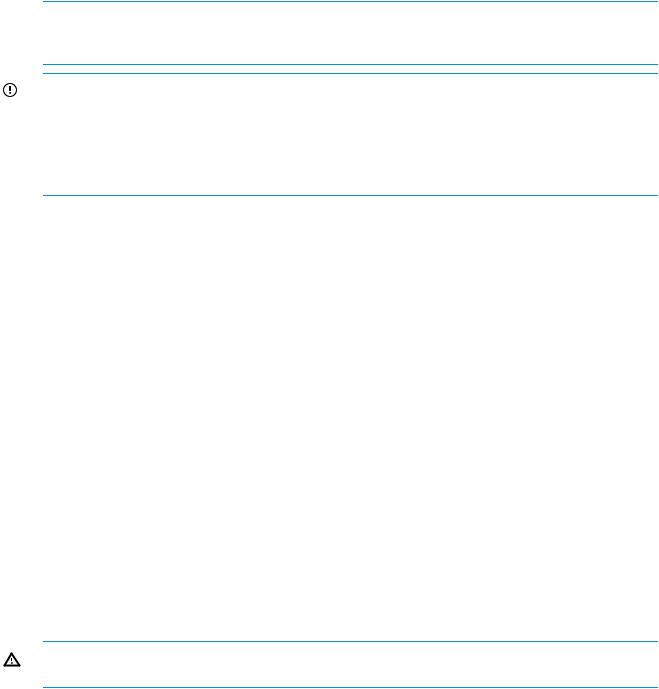
Data at Rest Encryption
When enabled, the Data at Rest Encryption security feature protects data at rest on a stolen, discarded, or replaced disk from forensic attack.
Creation of a new VTL library, Catalyst store, or NAS share provides the option to enable encryption if the security features license was already applied. Once enabled, encryption will automatically be performed on the data before it is written to disk. Encryption cannot be disabled once it is configured for a library, Catalyst store, or NAS share.
When creating an encrypted library, Catalyst store, or NAS share, the key store is updated with the encryption key. This key store may be backed up and saved securely offsite in case the original key store is corrupted. However, keep only the latest version of the key store as a backup. The key store on the StoreOnce Backup system is updated each time you create a library, Catalyst store, or NAS share. The StoreOnce CLI command that backs up the key store also encrypts it, ensuring it can only be decrypted by the HP StoreOnce backup system.
NOTE: Each configured library, Catalyst store, or NAS share uses a different key. The StoreOnce software automatically tracks which key is relevant to which device in the Key Store File. Keys are automatically re-applied to the correct device if the key store file is restored.
IMPORTANT: Be very diligent about backing up your keystore if you are creating encrypted stores or libraries. See the HP StoreOnce Backup system CLI Reference Guide for more information about the StoreOnce CLI commands for backing up and restoring key stores.
Every time that you expand storage by adding a couplet, you must restore your key store. Installing the additional couplet is an HP Support task, but you are responsible for ensuring that a Security license is installed for the new couplet and for saving the existing key store.
NOTE: The encryption feature is licensed per couplet. If you have multiple couplets in the StoreOnce Backup system cluster, obtain and apply a Security license for each couplet in the cluster. When mapping replication to target devices on a different StoreOnce Backup system, HP recommends that encryption is licensed and enabled on both the source and the target couplet or appliance.
Data in Flight Encryption
When enabled, the Data in Flight Encryption security feature protects data that is in transit from forensic attack using the IPsec protocol. The data can be moving between two StoreOnce Backup appliances or a StoreOnce Backup appliance and a backup server.
Data in Flight Encryption is configured using the net [add/modify/delete] encryption commands in the CLI; see the HP StoreOnce Backup system CLI Reference Guide for more information.
Secure Erase
Secure Erase can be enabled for all store types. This feature enables allows secure erasure of data that was backed up as part of a regular backup job. The Secure Erase feature can only be enabled after store or library creation (edit the store or library to enable Secure Erase). All data written to disk once Secure Erase is enabled will be securely erased upon data deletion. For example, you may have unintentionally backed up confidential data and need to be sure that it has been securely erased. Work with the backup application to trigger the Secure Erase, for example by forcing the format of a cartridge. The backup application sends the request to delete the data and the deletion is carried out as part of the Housekeeping function.
WARNING! To immediately remove data, ensure the backup application is configured correctly. Rotation and retention policies may need to be revisited to ensure that the data is expired.
Security Features 15

NOTE: The Secure Erase process may take some time depending on the Housekeeping workload.
Only chunks not referenced by any other items can be securely erased. If a chunk is referenced by another item which is not marked for Secure Erase, then the referenced chunk will not be erased, securely or otherwise. Use the backup application when performing a Secure Erase on stores, shares, or libraries that have Secure Erase enabled.
See “Licensing” (page 13) for information on how to apply the Security license for these features.
16 Getting started
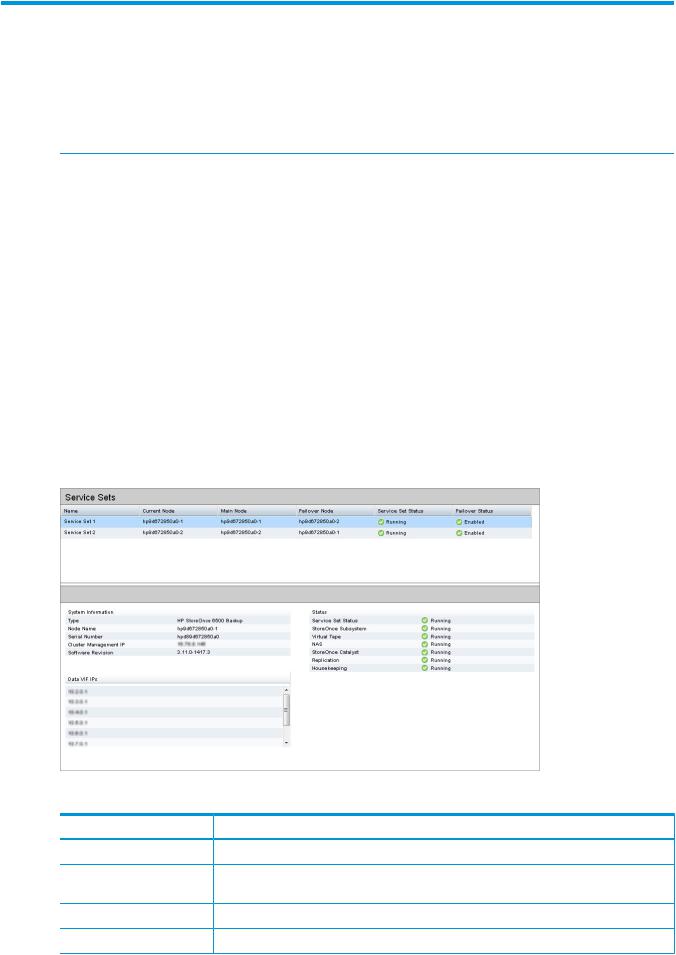
2 StoreOnce functions
The following topics are covered in this chapter:
•Overview of the HP StoreOnce page (page 17)
•Select service set dialog (page 18)
•System information and status (page 19)
NOTE: The StoreOnce Backup system must be configured on the network. Network configuration should only be changed under the guidance of HP Support.
Overview of the HP StoreOnce page
The initial page at GUI logon provides important information about system status and processes that are running (see System information and status (page 19)).
It also provides access to individual StoreOnce functions, which are available as sub topics (click + to display them in the Navigator).
•VTL (Virtual Tape Libraries) functions (page 21)
•NAS functions (page 38)
•Replication functions (page 59)
•HP StoreOnce Catalyst functions (page 90)
•Housekeeping (page 119)
•StoreOnce reporting (page 124)
Table 2 Service set parameters
Field |
Description |
Name |
The name of the Service Set. |
Current Node |
The node on which the Service Set is currently running. This is normally the same as the |
|
Main node, unless a failover state has been invoked. |
Main Node |
The name of the node on which the Service Set normally runs. |
Failover Node |
The name of the failover node for the Service Set. |
|
Overview of the HP StoreOnce page 17 |
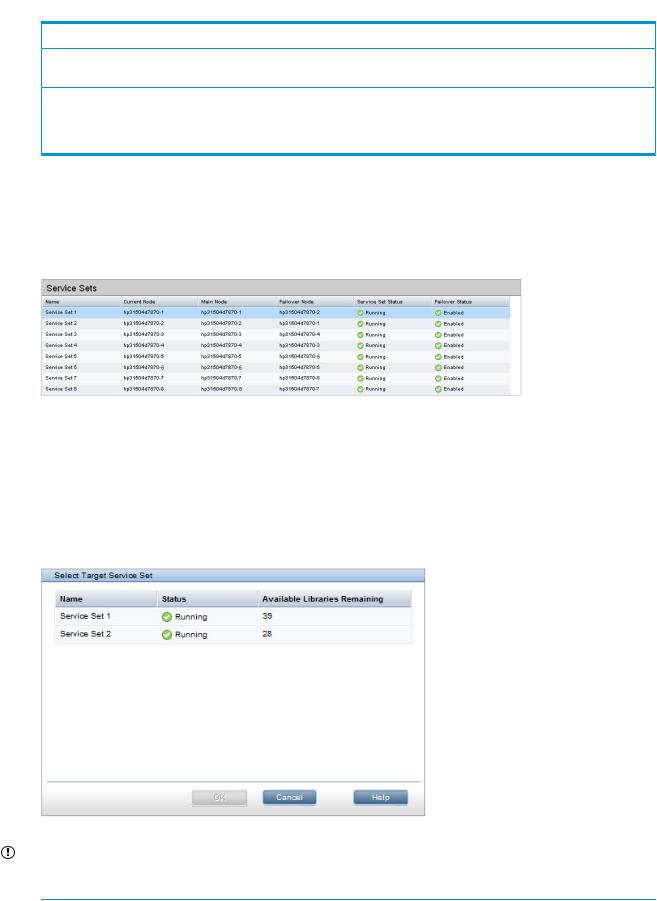
 Table 2 Service set parameters (continued)
Table 2 Service set parameters (continued)
Field |
Description |
Service Set Status |
The status of the Service Set, such as: Running, Starting, Fault, Not Started, Stopped, or |
|
Unknown. |
Failover Status |
The failover status of the Service Set. The three possible values for each service set are: |
|
Enabled (green), Disabled (yellow), and Failed Over (red). This field is particularly useful |
|
when running software upgrades or after a reboot to check the failover status of Service |
|
Sets. |
Click on a service set to display status information for the services running on that set.
Click on any column heading to change the sort order or select which columns are displayed.
A single-couplet configuration has two Service Sets. This is the minimum configuration. Additional couplets increase Service Sets, two for each couplet, up to a maximum of eight. The following example shows a configuration with eight Service Sets. Therefore, it has four couplets.
Select service set dialog
A service set is a collection of various services, such as VTL, NAS, Replication, and StoreOnce Catalyst. There is one instance of each service per service set. The auto-configuration process registers and starts a service set by launching a process on the server for each of the services.
Administrators can create elements such as libraries, NAS shares, replication mappings, and StoreOnce Catalyst stores for a service set. When creating such an element, the system prompts you to select the target service set to which it relates.
IMPORTANT: The number of available service sets depends on the number of couplets in the cluster configuration. The minimum is 2 (for a single couplet in one rack), the maximum is 8 (for a two–rack installation with four couplets).
18 StoreOnce functions

Table 3 Select Target Service Set parameters
Parameter |
Description |
Name |
The name of the Service Set. There are two for each couplet |
|
in your cluster configuration. |
Status |
The status of the Service Set. |
Available <devices> Remaining |
This column is displayed when you create a new library |
|
or share. It indicates how many devices you can still create |
|
for this service set. The maximum devices available |
|
depends upon the number of couplets in your configuration. |
|
The maximum is 48 for a single couplet. |
Why are there two service sets for each couplet?
There are two service sets for each couplet installed in the HP StoreOnce rack to ensure resilience and failover. Each Service Set has a VIF associated with it. This VIF is the IP address used to configure replication mappings and StoreOnce VTL, NAS, or Catalyst devices as backup targets in the backup application.
Each node in a couplet can run both service sets if required in the event of a node failure, and each service set has its own set of service processes and storage. Each service set is associated with:
•A primary node, the node on which it usually runs.
•A secondary node, where it will run if its primary node fails.
This allows each node to act as the secondary node for the main Service Set on the other. In the event of a failover, the service set moves transparently from the primary node to the secondary node. Because each storage cluster in the couplet has two connections, one from each node, the service set can still access its storage on the primary node even though it is now running on the secondary node.
Maximum device considerations
The HP StoreOnce Backup system supports a maximum number of virtual devices. This number may be split across VTL, NAS, and Catalyst devices. The table in Create a library (page 26) illustrates some possible configurations. For more detailed examples refer to StoreOnce key parameters (page 199) and the HP StoreOnce Backup system Concepts and Configuration Guidelines.
System information and status
System information
This section provides information unique to an individual HP StoreOnce Backup system.
Table 4 System information parameters
Parameter |
Description |
Type |
The type of server for the node on which the Service Set is running. |
|
Using StoreOnce software version 3.11.00, you can add StoreOnce 6500 couplets to |
|
a StoreOnce B6200 Backup system. This configuration is referred to as a mixed cluster |
|
configuration. |
Node Name |
The node name for this Service Set. |
Serial Number |
The serial number of the node on which the Service Set is running. (Note: this serial |
|
number is for internal use only; it is not the serial number that should be used when |
|
contacting HP Support. See Important information about serial numbers (page 178).) |
System information and status 19

 Table 4 System information parameters (continued)
Table 4 System information parameters (continued)
Parameter Description
Cluster Management IP |
The IP address that provides access to the StoreOnce Management Console (GUI and |
|
CLI) and applies to the whole cluster, not individual couplets. |
Software Revision |
The software revision of the node on which the Service Set is running. Use this when |
|
adding couplets to check that all Service Sets are running the latest and same software. |
Data VIF IPs |
The Data VIF IP addresses for data. These are the addresses that you should use when |
|
configuring backup applications to send data to the StoreOnce Backup. |
|
If vLAN tagging has been configured on your network, there is an option to expand the |
|
list so that you can see all the vLAN IP addresses that have been configured. For more |
|
information about vLAN tagging, see your product’s HP StoreOnce Backup system |
|
Installation Planning and Preparation Guide andChecklists. |
Status
This section provides details about the rolled-up system status of the Service Set and the status of the services running.
Table 5 Status parameters
Parameter |
Description |
Service Set Status |
The state of the Service Set. |
StoreOnce Subsystem |
The status of the background support processes such as EventManager and |
|
ResourceManager. |
Virtual Tape |
The status of the VTL service. |
NAS |
The status of the NAS service. |
StoreOnce Catalyst |
The status of the StoreOnce Catalyst service. |
Replication |
The status of the Replication service. |
Housekeeping |
The status of the Housekeeping service. |
20 StoreOnce functions
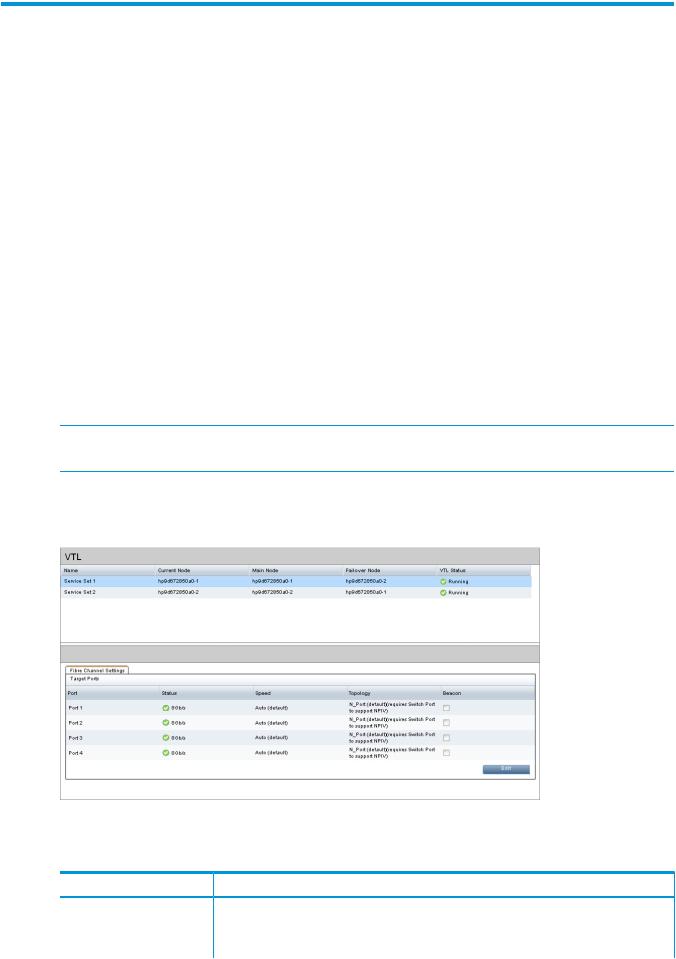
3 VTL (Virtual Tape Libraries) functions
The following topics are covered in this chapter:
•VTL page (page 21)
•Libraries page (page 23)
•Make Replication Target libraries visible to the host (page 36)
Licensing requirements
•No licensing is required for VTL emulations unless using the Security features, Data at Rest Encryption, and Secure Erase.
•VTL replication requires a license (per couplet) on the target site, but only if VTL replication is used on that couplet.
•Replication encryption using IPSEC is part of the Security license but is enabled via the CLI. See the HP StoreOnce Backup system CLI Reference Guide.
VTL Configuration page
Select VTL from the HP StoreOnce menu to display the current VTL configuration.
The HP StoreOnce–VTL page includes the following tabs:
•Fibre Channel Settings tab (page 21)
NOTE: Equivalent StoreOnce CLI commands are available for the tasks described in this section. See the HP StoreOnce Backup system CLI Reference Guide.
The top half of this page displays available service sets. Click on the service set to display the Fibre Channel Settings tab for the VTL devices configured for that service set in the lower half of the page.
Fibre Channel Settings tab
Table 6 Fibre Channel settings
Setting |
Description |
Port |
Four Fibre Channel ports are on each node, and therefore four ports are available for |
|
each service set. |
|
See also Port assignment for StoreOnce Backup systems (page 22). |
VTL Configuration page 21
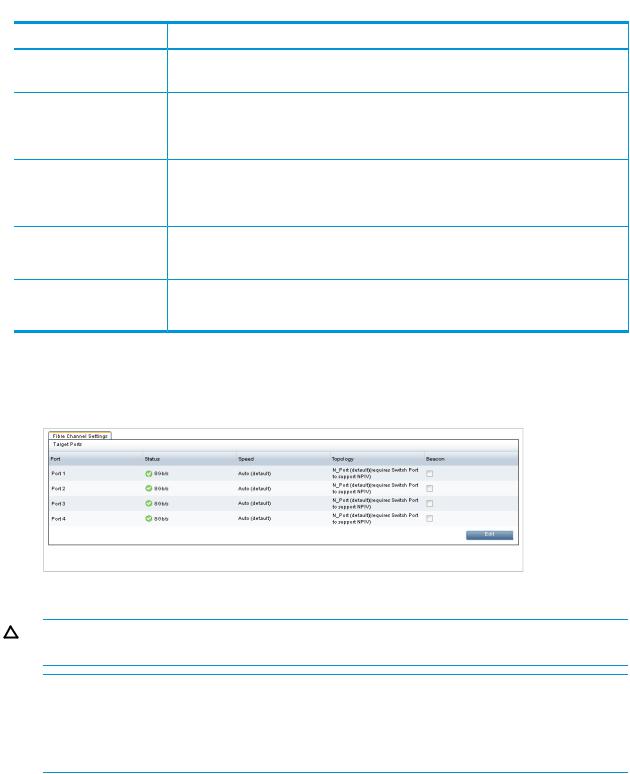
 Table 6 Fibre Channel settings (continued)
Table 6 Fibre Channel settings (continued)
Setting |
Description |
|
Libraries can be configured to use the ports in various combinations. See Create a |
|
library (page 26) for more information. |
Status |
This reflects the current status of each port, which may be OK, Warning, Error, or Not |
|
Used. Warnings occur if the port is not available or is down. They also appear if the |
|
system is unable to obtain Speed information. Errors occur if there is a fault or the system |
|
cannot obtain the link status. |
Speed |
The default is Auto, which is the recommended option. The speed will be auto-negotiated |
|
between the switch and StoreOnce appliance to choose the highest supported speed. |
|
For users who wish to fix the speed, other values are available, as follows: 8Gbs |
|
(preferred), 4Gbs or 2Gbs (not recommended). |
Topology |
The default is N_Port, when a single target device creates many virtual devices on a |
|
fabric attach port. N_Port requires the switch port to support NPIV (N_Port ID |
|
Virtualisation). |
Beacon |
Individual ports can be “beaconed” via the GUI. This toggles an LED on the physical |
|
HBA. The color of this button changes to show the current status of the beacon; grey is |
|
off, blue is on. This column is not displayed in Edit mode. |
To edit Fibre Channel settings
Users with an Admin login may edit these settings.
1.Click Edit to make the fields configurable for each port.
2.Make the preferred changes to the speed and/or topology, and click Update.
CAUTION: This resets the Fibre Channel link and may affect any backup or restore jobs running.
NOTE: Fibre Channel settings apply to the whole appliance. The settings can also be edited in the Catalyst section of the GUI if you are backing up to Catalyst target devices over Fibre Channel. Fibre Channel settings, defined on either page, apply to all target devices being backed up over Fibre Channel. Therefore, any changes here will also apply to Catalyst target devices over Fibre Channel and vice versa.
3.Click Continue at the warning prompt to continue applying the changes. Changes affect all service sets running on the node.
Port assignment for StoreOnce Backup systems
When creating a library you may select individual drives or Fibre Channel ports 1&2 or Fibre Channel ports 3&4. Be aware that Port 1 and port 3 are on the first Fibre Channel card, which is in slot 2; port 2 and port 4 are on the second Fibre Channel card, which is in slot 3, so it is important to ensure that the system has been cabled correctly when connecting to the Fibre Channel SAN. If you select one of the combined port options, both Fibre Channel cards must be connected.
22 VTL (Virtual Tape Libraries) functions
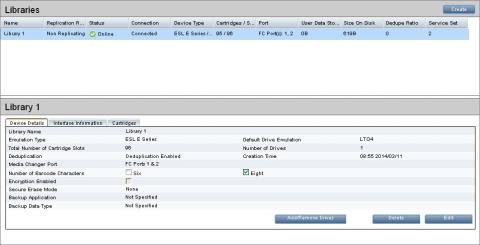
Drives can only appear on one port, so when you choose a pair of ports, drives are automatically distributed evenly across both ports to ensure best performance and failover. After creating the library, it is possible to change the drive assignments using the edit function on the Interface Information tab for the selected library. See Interface information tab (page 29).
Libraries page
Click VTL — Libraries in the Navigator panel to display existing libraries.
The top half of the Libraries page shows all libraries configured for the couplet; the service set is shown in the right-hand column. Click on a library to display its details in the lower half of the page. Users with an Admin login may edit these settings and delete or create libraries.
VTL devices are always Fibre Channel libraries.
The lower half of the Libraries page contains tabs that display information relevant to the selected library:
•Device details tab (page 24)
•Interface information tab (page 29)
•Cartridges tab (page 30)
Working with the Libraries list (top half of page)
The Libraries list in the top half of the page provides up to 11 columns of details.
•To sort the list according to a column, click on the column heading and select Sort Ascending or Sort Descending.
•To hide or show columns, click on any column heading, select Columns and uncheck or check the preferred columns.
•Users with an Admin login may also create libraries. Click Create. See Create a library (page 26) for more information.
•Users with an Admin login may edit details on some of the tabs for individual libraries (not all tabs have editable information). The relevant GUI buttons are on the tab. For example, each Edit button shall trigger edit mode only for the current tab. When in edit mode, each tab shall have its own Update and Cancel buttons. If a user changes tab while in edit mode a warning dialog advises that any changes they have made will be lost.
The Delete button is on the Device Details tab only and will delete the entire library.
Libraries page 23
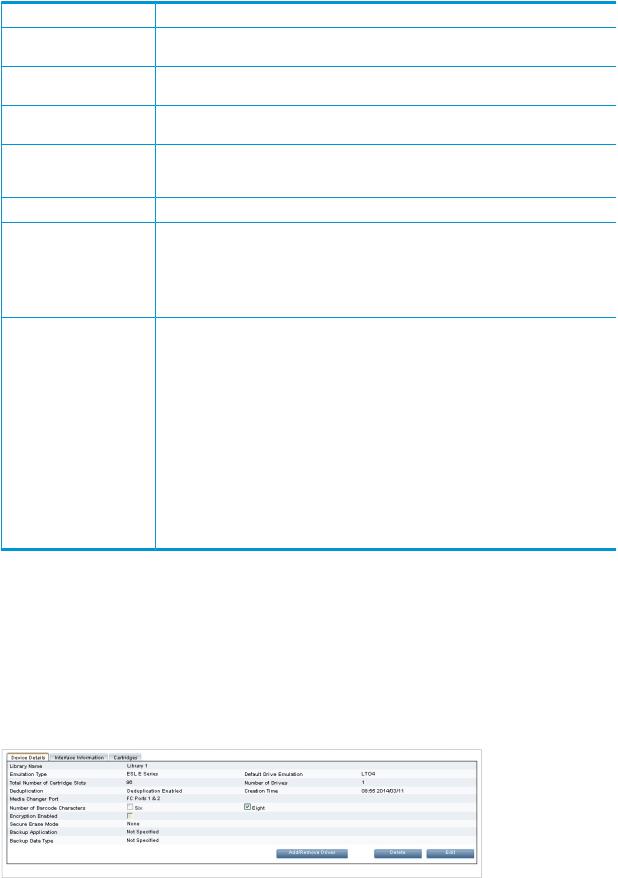
Table 7 Libraries parameters (top half of page)
Parameter |
Description |
Name |
Identifies the selected device (library). HP recommends usnig a name that identifies the |
|
host or backup job with which it is associated. |
Replication Role |
The role of the library, which may be non-replicating, replication source or replication |
|
target. |
Status |
The status of the library, which may be online, offline, notstarted, failed to start, stopping, |
|
creating, or deleting. |
Connection |
Indicates whether the library is connected. Possible values are: Connected – A client |
|
device is connected to any device (robotics or drive) within this library. Not Connected |
|
– No device is connected to this library. |
Device Type |
The emulation type used by the backup software. It is selected when you create a device. |
Cartridges / Slots |
The number of cartridges or slots available on the device, which is determined by the |
|
Emulation types for tape device selected when the device was created. You can reduce |
|
the number of slots in the Device Details tab for a library selected on this page, but this |
|
will only remove the highest empty slots. Once it reaches a slot number that contains |
|
data, it will not allow you to reduce the number further on this page, even if earlier slots |
|
are blank. You must first use the Cartridges tab to make the slot empty. |
Port |
Identifies the port to which the host is connected for backup and restore. The number of |
|
ports available in the drop-down menu depends upon the interfaces that your model |
|
supports and your network configuration. |
|
There are four Fibre Channel ports available. When creating a library you may select |
|
individual drives or Fibre Channel ports 1&2 or Fibre Channel ports 3&4. |
|
See also Port assignment for StoreOnce Backup systems (page 22) for important |
|
information about cabling Fibre Channel ports and drive assignment. |
User Data Stored |
The amount of user data stored on the library. |
Size On Disk |
The actual size used on disk (after deduplication). |
Dedupe Ratio |
The deduplication ratio achieved on the data on the library. If deduplication is disabled, |
|
the column displays “Dedupe Disabled.” |
Service Set |
The service set (or node) to which the library belongs. |
Device Details tab
This tab displays device-specific information for the selected library.
Users with an Admin login may perform the following tasks from this tab:
•Create a library (page 26)
•Edit a library (page 27)
•Delete a library (page 28)
•Make Replication Target libraries visible to the host (page 36)
24 VTL (Virtual Tape Libraries) functions

Table 8 Device Details tab
Field |
Description |
Library Name |
The name used to identify a particular library. Enter a name that identifies the host or backup |
|
job with which it is associated. |
Emulation Type |
The emulation type of the library. The HP StoreOnce Backup system supports a number of |
|
emulation types. The default is D2DBS Generic. See also Emulation types for tape |
|
device (page 28). The emulation type determines the available embedded drives and |
|
cartridge slots. For example, if you select HP MSL G3 Series (2x24), the device emulates |
|
an MSL 2024 Library with two embedded tape drives and a possible total of 24 cartridge |
|
slots. Consult your backup application technical support information for information about |
|
device types they support. |
Drive emulation |
The drive emulation type, HP LTO–2, 3, 4, 5 or 6, determines the default capacity of the |
|
cartridges within the library device. Tape cartridge capacities can be increased at any time |
|
(but not decreased), as long as the cartridge is blank, regardless of the drive emulation |
|
generation number. |
|
If you selected D2DBS Generic for the Library Emulation Type, Ultrium VT is an option for |
|
drive emulation. This is a generic Ultrium device which is clearly identifiable as virtual. |
|
Where supported by the backup application, HP recommends that D2DBS Generic and |
|
Ultrium VT are used in preference to the other emulation types. |
|
All drives on a library configured with the IBM-TS3500 emulation type will use the IBM-LTO3 |
|
drive emulation type. If the library is then changed to a different emulation type, the drives |
|
will change to the new emulation type. |
|
If you edit this field, the new setting applies only to the next drives that are created within |
|
the library, it is not retrospectively applied to existing drives. |
Total Number of |
Define the number of cartridge slots in the library. The number of slots available depends |
Cartridge Slots |
upon the Emulation Type selected. Each slot is automatically populated with a new cartridge |
|
upon creation. The cartridge capacity corresponds to the Drive Emulation type. |
|
You can change the maximum size of the cartridge as long as it is blank. This means that |
|
the value can only be changed after the device is created and before it is accessed by the |
|
backup application. |
Number of Drives |
The default number of drives is determined by the Emulation Type selected. If increasing the |
|
number of drives, DO NOT exceed the maximum number of libraries and drives that a host |
|
can physically access: see StoreOnce key parameters (page 199). The number of drives can |
|
only be edited during library creation from this field. After library creation, there is a separate |
|
button to Add/Remove drives. |
Deduplication |
Enables deduplication if the check box is selected (default); unselect to create a |
|
non-deduplication library. Deduplication cannot be enabled or disabled once the library is |
|
created. |
Creation Time |
The date the library was created is generated automatically. |
Media Changer Port |
Identifies the port on the HP StoreOnce Backup system to which the device is connected. |
|
This will be the port used for the Library device as well as the default port for embedded |
|
tape drives. The number of ports available in the drop-down menu depends upon the |
|
interfaces that your model supports and your network configuration. |
|
There are four Fibre Channel ports available. When creating a library you may select |
|
individual drives or Fibre Channel ports 1&2 or Fibre Channel ports 3&4. |
|
See also Port assignment for StoreOnce Backup systems (page 22) for important information |
|
about cabling Fibre Channel ports and drive assignment. |
Number of Barcode |
Enables configuration of the barcodes for the library to display six or eight characters. The |
Characters |
HP StoreOnce Backup system generates barcodes automatically for cartridges. When entering |
|
a barcode manually, 8 characters are required. If the 6–character barcode is selected, the |
|
StoreOnce Backup system will truncate to the top six characters, removing the top two |
|
characters of an 8–character barcode, i.e. barcode 1ABCDEFG will truncate to BCDEFG. |
|
The barcode is displayed with the truncated characters in brackets on the Cartridges tab, |
|
(1A)BCDEFG. |
Encryption Enabled |
Enables Data at Rest Encryption if you applied a Security license. Encryption cannot be |
|
enabled or disabled once a library is created; it can only be enabled at library creation. If |
Libraries page 25
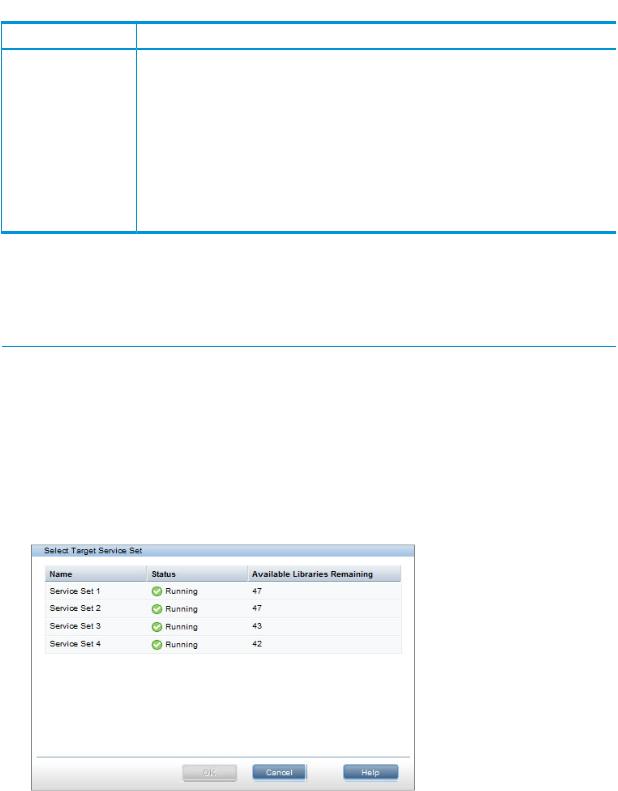
 Table 8 Device Details tab (continued)
Table 8 Device Details tab (continued)
Field |
Description |
|
enabled, encryption is performed prior to writing data to disk for this library. The correct |
|
license must be applied to enable encryption. |
Secure Erase Mode |
Enables Secure Erase if you have applied the Security license. “None” leaves it disabled |
|
(default). To enable, select the number of preferred Overwrite Passes (1, 3, 5, or 7). This is |
|
the number of times the data is written over after deletion. See “Secure Erase” (page 15) |
|
for information about the Secure Erase feature. |
Backup Application |
The backup application used on the system. This optional field is provided to assist with |
|
support troubleshooting and has no impact on performance or deduplication efficiency. |
Data Type |
The type of data being protected by the backups. This optional field is provided to assist |
|
with support troubleshooting and has no impact on performance or deduplication efficiency. |
To create a new library (administrators only)
HP recommends:
•Only configure the libraries that you need
•Only configure the number of cartridges that you are likely to need
NOTE: Refer to the HP StoreOnce Backup system Concepts and Configuration Guidelines, available on the HP Support web site, for guidelines on setting up a backup policy/job within backup applications. This document is helpful in determining the required number of libraries and cartridges.
You can add cartridge slots at a later date to expand the system and remove individual blank cartridges from a library without deleting the whole library.
1.To create a new library device for the host, click Create in the upper left corner of the screen.
2.Select a service set for the new library and click OK. The information on the service set identifies how many libraries are still available.
3.Enter the appropriate details in the Device details tab (page 24).
To enable Data at Rest Encryption for the new library, configure it at this time by checking the Encryption Enabled box. This feature requires a license. If the license is not installed, an information message is displayed next to the check box stating Not Licensed. See “Security Features” (page 14) and “Licensing” (page 13) for more information.
26 VTL (Virtual Tape Libraries) functions
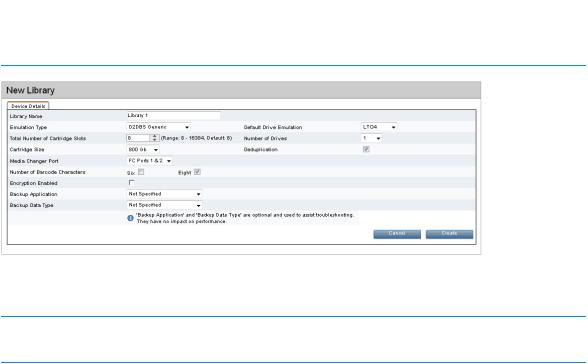
NOTE: The Replication Wizard does not allow creation of an encrypted target library. If a replication target library needs encryption enabled, you must create the library on the target appliance before replication mapping to it.
4.Click Create. The Cartridges tab is only generated after the library is created. The information on the Interface Information tab is generated automatically.
NOTE: Once the library has been created, you can enable Secure Erase. See “Edit a library” (page 27) for more information.
Guidelines on creating libraries
There is a maximum of 48 virtual devices per service set. This number may be split across VTL, NAS, and Catalyst devices. For detailed examples, refer to the HP StoreOnce Backup system Concepts and Configuration Guidelines.
To edit library details (administrators only)
It is possible to edit some, but not all, device details after creating a library.
•Delete cartridges by reducing the number of slots on the Devices page. This will only remove the highest-numbered empty slots. Once the Delete operation reaches a slot number that contains a cartridge, it will not allow further reduction on the Details page, even if previous slots are empty. To open previous slots first use the Cartridges tab to delete the cartridge from the slot.
•Changing the cartridge size (by changing the emulation type) on this page will only change newly-added cartridges; it does not change the size of cartridges that were already created.
•You can reduce the number of drives but, if you go to 0, the port setting will change to "No Port".
The Number of Drives field can only be edited during library creation. After library creation, there is a separate button to Add/Remove drives.
•You cannot change the library type to a type that has a smaller set of maximum values (e.g. number of cartridges) than is currently set.
•You cannot enable or disable deduplication.
•Once the library is created and the correct license is applied, the Secure Erase Mode box appears on the Device Details tab. The selection box defaults to None, meaning Secure Erase is disabled. To enable Secure Erase, select the preferred number of Overwrite Passes (1, 3, 5, or 7). If enabled, this feature allows you to securely erase confidential data that may have unintentionally been backed up as part of a regular backup job. See “Security
Features” (page 14) and “Licensing” (page 13) for more information.
Libraries page 27
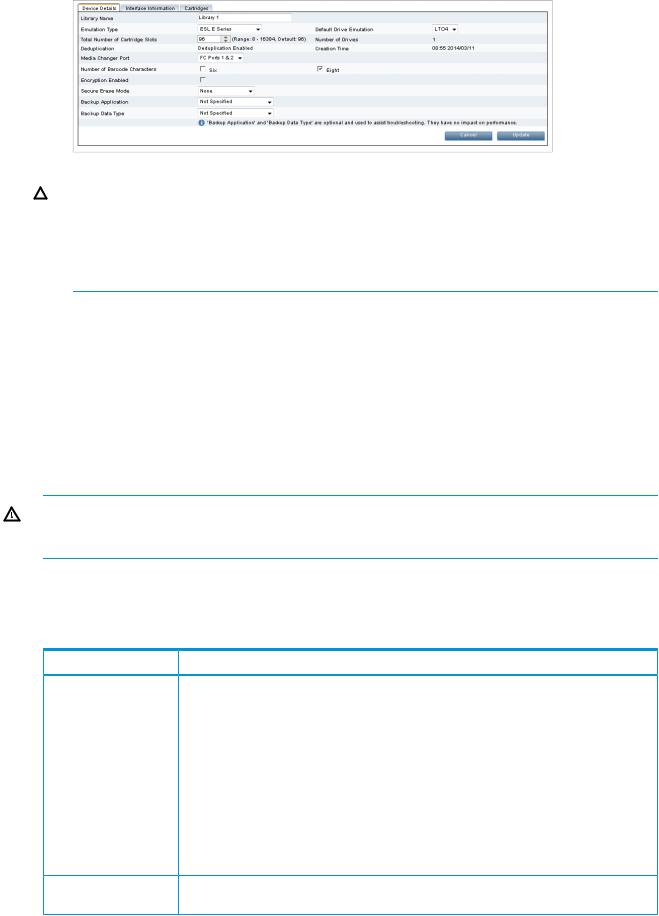
1.Select the device in the list to display its details and then click on Edit.
CAUTION: Take care if you change the Port configuration because the system does not automatically reassign any drives that may now be configured incorrectly. A Warning is displayed. For example, if you change from the Fibre Channel Port 1&2 to a single Fibre Channel Port, when the status shows ready and restarted, you must manually correct those drives that are connected to the wrong port, using the Interface Information tab. See Interface information tab (page 29).
2.Amend details as appropriate and click Update to apply them.
To add/remove drives
1.Click Add/Remove drive.
2.The maximum number of drives is shown, below which you can edit the Number of Drives.
3.Click OK. If you provide an invalid value the text box will be surrounded in a red border.
To delete a library (administrators only)
Select the required device and then click Delete on the Device Details tab to delete it. You will be prompted to confirm deletion.
WARNING! All data on the device will be deleted. The library's deduplication store is also deleted. It may take some time to delete all the files and free space on the HP StoreOnce Backup system. If Secure Erase is enabled for this store, this data will be deleted securely.
Emulation types for tape devices
HP StoreOnce Backup systems emulate a range of physical tape devices listed in Emulation types.
Table 9 Emulation types for tape devices
Emulation type |
Description |
D2DBS Generic |
A tape library device that allows you to configure up to 500 drives per node and up to |
|
16384 cartridges per library. |
|
If supported by your backup application, this is the preferred emulation type because it does |
|
not emulate any physical library types in existence and is, therefore, clearly identifiable as |
|
a StoreOnce device. It is the most flexible emulation type available; however, backup |
|
application support varies by software vendor. |
|
If you have selected D2DBS Generic for the Library Emulation Type, you will be able to |
|
select Ultrium VT for the drive emulation. This is a generic Ultrium device which is clearly |
|
identifiable as virtual. Backup application support for Ultrium VT is common, but not quite |
|
as complete as the D2DBS library type, so its not possible to use it with all backup software. |
|
NOTE: Symantec prefers their customers use this emulation type with BackupExec and |
|
Netbackup. |
EML E Series |
An enterprise tape library solution that allows you to configure up to 500 drives per node |
|
and up to 16384 cartridges per library. |
28 VTL (Virtual Tape Libraries) functions

 Table 9 Emulation types for tape devices (continued)
Table 9 Emulation types for tape devices (continued)
Emulation type |
Description |
ESL E Series |
An enterprise tape solution that allows you to configure up to 500 drives per node and up |
|
to 16384 cartridges per library. |
IBM-TS3500 |
A tape library device that appears as a native IBM TS3500 device in a TSM environment |
|
to allow use of standard IBM drivers. The emulation type is configured at the library level. |
|
Therefore, all drives on a library configured with the IBM-TS3500 emulation type will use |
|
the IBM-LTO3 drive emulation type. If the library is then changed to a different emulation |
|
type, the drives will change to the new emulation type. |
MSL G3 Series (2x24) |
A tape library device with a maximum of two embedded Ultrium tape drives and 24 cartridge |
|
slots. It should be used when implementing rotation schemes which involve simultaneous |
|
backup jobs to two devices. This emulation type is widely supported by backup applications. |
MSL G3 Series (4x48) A tape library device with a maximum of four embedded Ultrium tape drives and 48 cartridge slots. It should be used when implementing rotation schemes which involve simultaneous backup jobs to more than two devices or those that use a large number of cartridges devices. This emulation type is widely supported by backup applications.
MSL G3 Series (8x96) A tape library device with a maximum of eight embedded Ultrium tape drives and 96 cartridge slots.
Flexible emulation
The ESL, EML and D2DBS emulations are particularly flexible because they allow you to configure a large number of drives per library. The main benefits are that a large number of drives allows:
•more concurrent streams on backups which are throttled due to host application throughput, such as multi-streamed backups from a database.
•a single library (and therefore deduplication store) to contain similar data from backups that must run in parallel to increase deduplication ratio.
If using these flexible emulation types, the following factors should also be considered:
•An important consideration when configuring VTL devices is that the library and each drive that you configure for it counts as a separate device. There are practical limitations on the number of devices that each host and Fibre Channel switch or HBA can access. See StoreOnce key parameters (page 199).
Although there are no hard limits on the number of drives that can be configured per library, there are limits on the total number of libraries and drives that can be configured on an appliance node. If you configure one library with 500 drives on an HP 6500 or B6200 Backup system, you will still have 47 libraries available in theory, but you will have no more drives.
•The total device value also applies to NAS shares and Catalyst stores. If you configure the full value as VTL devices, you will not be able to configure any NAS shares or Catalyst stores for that node.
•Refer to the HP StoreOnce Backup system Concepts and Configuration Guidelines for maximum and recommended values.
Interface Information tab
This tab shows interface information for the media changer and drives on the selected library.
The information for the Interface Information tab is generated automatically and manual configuration is discouraged.
However, you may use this tab to adjust the port to which a drive has been assigned; see To change drive assignment (page 30).
The following information is provided for a device that is configured to use the Fibre Channel interface.
Libraries page 29
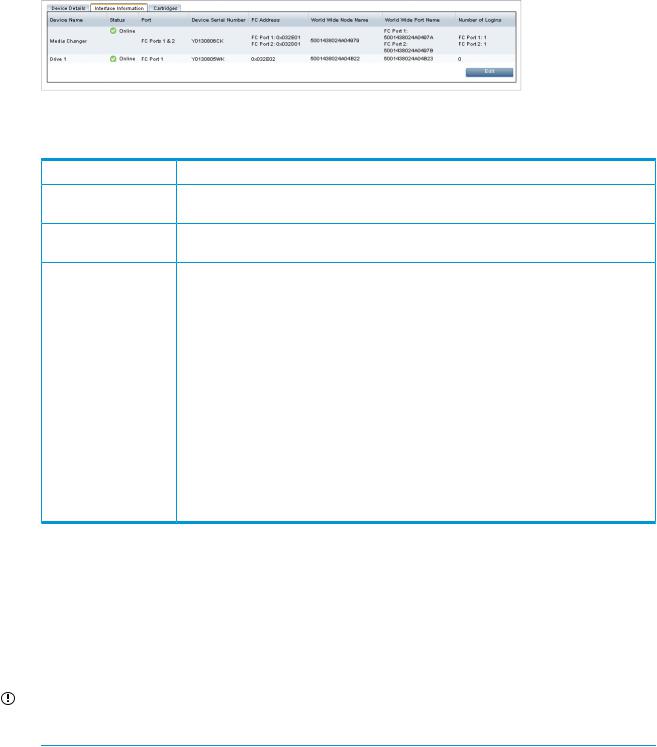
Fibre Channel interface
Table 10 Fibre Channel Interface Information
Field |
Description |
Device Name |
Lists all of the devices for the specific Library. There are entries for the Media Changer and |
|
for each of the drives configured. |
Port |
Defines the Fibre Channel port to which each media changer or drive is connected. See |
|
also To change drive assignment (page 30). |
Device Serial Number |
A unique serial number for the device. It is generated automatically by the HP StoreOnce |
|
Backup system and cannot be edited. |
|
Note: this serial number is for internal use only, it is not the serial number that should be |
|
used when contacting HP Support. See Important information about serial numbers (page 178) |
|
for more information. |
FC Address |
The Fibre Channel addresses of the device. |
World Wide Node |
Provided when the device is created. You can change this, if necessary, but not to any names |
Name |
used by libraries or drives on the local appliance. |
World Wide Port Name |
Generated automatically by the HP StoreOnce Backup system and used for Fibre Channel |
|
zoning for Fibre Channel devices. You can change this, if necessary, but not to any names |
|
used by libraries or drives on the local appliance. Libraries split across multiple ports have |
|
multiple versions of this field. |
Number of Logins |
Fibre Channel libraries show the number of logins for each device in the library. Libraries |
|
split across multiple ports have multiple versions of this field. |
To change drive assignment on Fibre Channel ports
When creating a library, drives are automatically assigned based upon the specified port configuration. If you select a pair of ports, the drives are distributed equally across both ports. To change drive assignment:
1.Click Edit.
2.For each configured drive, select the required port from the drop-down list.
3.Click Update.
IMPORTANT: Be aware that Port 1 and port 3 are on the first Fibre Channel card, which is in slot 2; port 2 and port 4 are on the second Fibre Channel card, which is in slot 3, so it is important to ensure that the system has been cabled correctly when connecting to the Fibre Channel SAN.
Cartridges tab
This tab shows cartridge information for the selected library.
Users with an Admin login can perform the following tasks from this tab:
•Create a cartridge (page 32)
•Delete a cartridge (page 32)
•Write protect a cartridge (page 33)
•Edit maximum cartridge size (page 34)
30 VTL (Virtual Tape Libraries) functions
